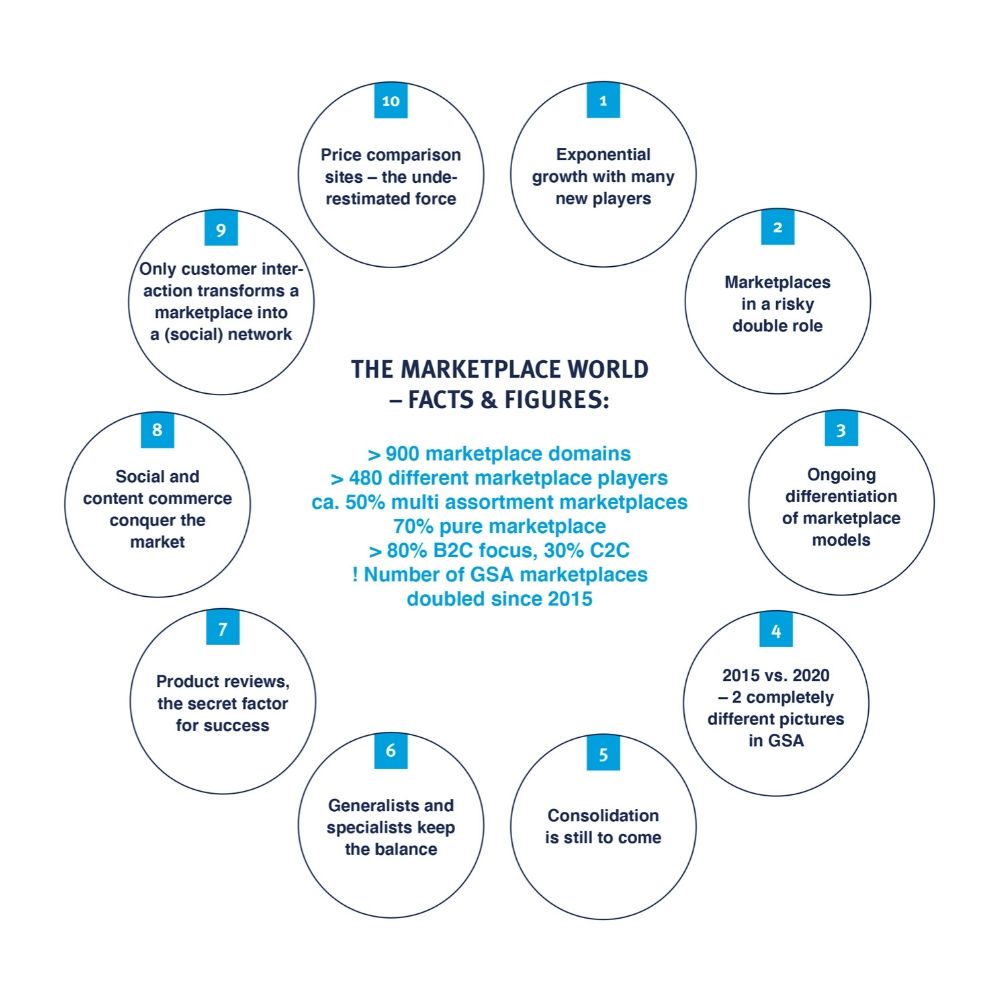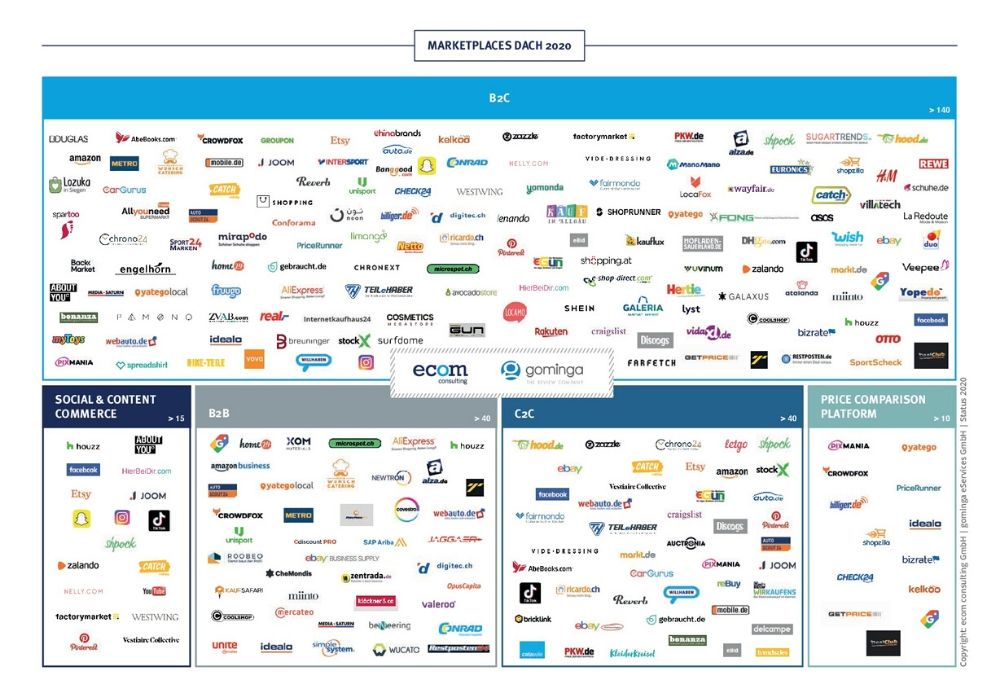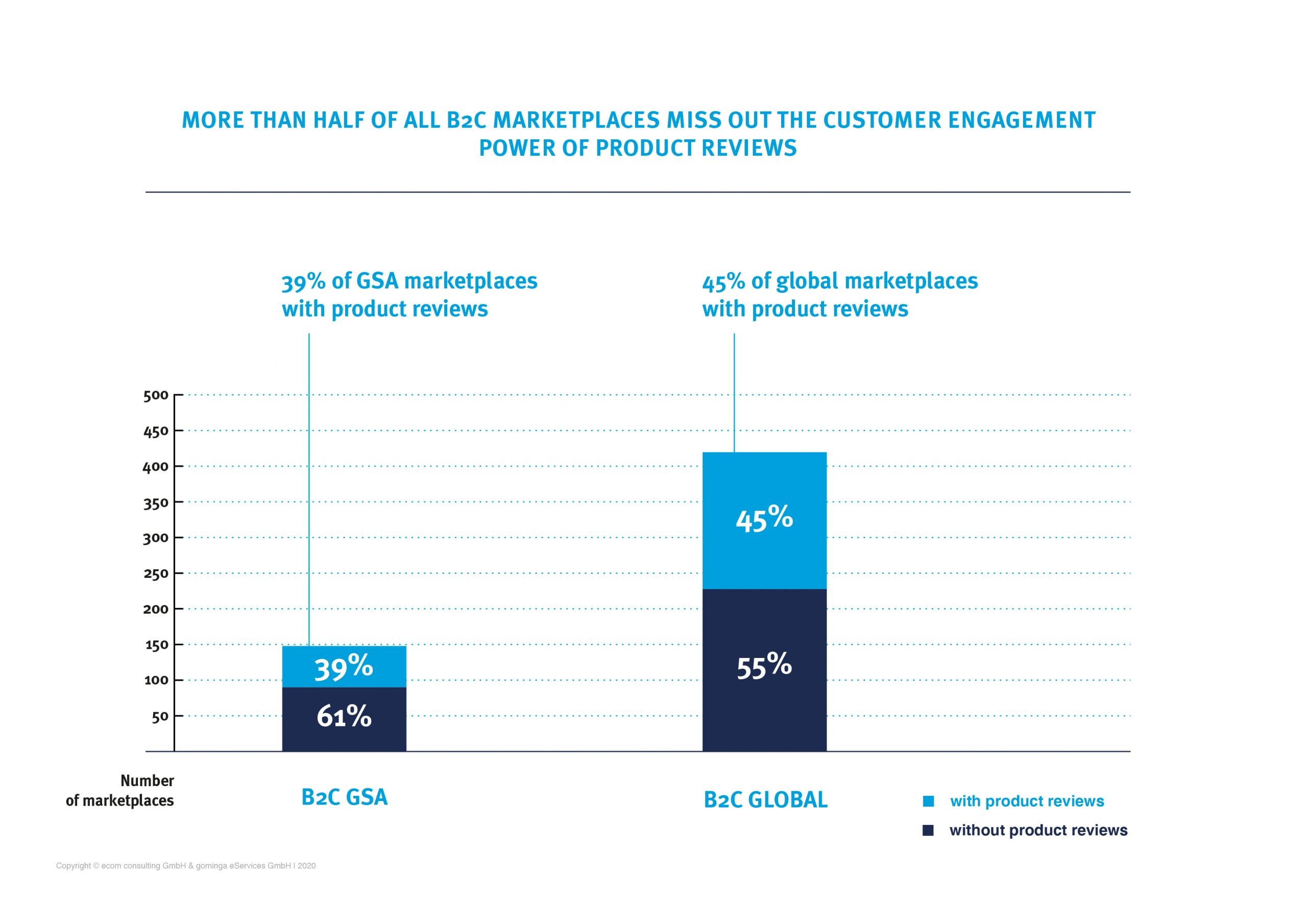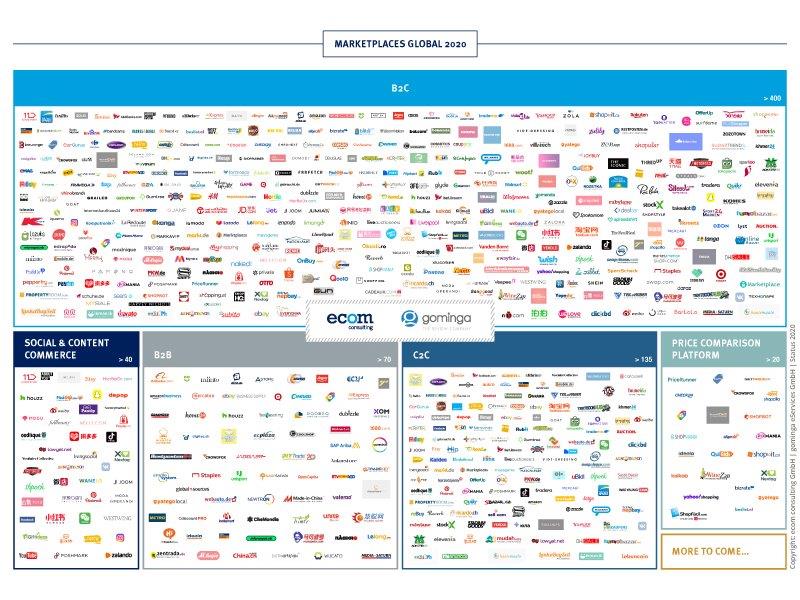Online marketplaces – highly dynamic, complex and disruptive.
Facts & figures.
STUDY IS IN GERMAN ONLY, THIS IS A TRANSLATED SUMMARY
We are very pleased about the publication of our marketplace study, which we have worked out together with our friends from ecom consulting GmbH over the past months.
The last weeks of the pandemic have clearly shown the (system) relevance of online marketplaces in global e-commerce. However, anyone who talks about marketplaces today, and thus thinks only of Amazon and eBay, fails to appreciate the complexity and dynamics of this market. With our study “Marketplace World 2020”, we are now shedding light on the subject for the first time and providing an important basis for discussion for business and politics.
Even before the outbreak of the corona pandemic, it was clear that the age of platforms had dawned and online marketplaces were becoming increasingly relevant. COVID-19 further reinforces and accelerates this trend. The boom now includes an enormous number of providers and offers a wide range of potential. In total, more than 480 players worldwide and more than 170 in the GSA region operate various marketplace models. This means that the number of players in the GSA region alone has more than doubled in the last five years. On a global level, the growth figures as well as the dynamics of change and innovation are also remarkable.
For the first time, the consulting firm ecom consulting and the review company gominga have systematically recorded the international marketplace landscape in the period September 2019 to January 2020.
Brand manufacturers and dealers, politics and research as well as media and opinion leaders can now reassess their actions on this factual basis. In its analysis, the team of authors comes to the following conclusions in its 10 Key Findings.
Table of Content:
“With our study we want to illustrate the complexity and heterogenity of the online marketplace industry. This is the only way to enable a more differentiated and well-founded discussion on opportunities, risks and the rules of success of marketplaces.”
Christian Driehaus, Co-Founder of gominga
Marketplace Study 2020
FREE DOWNLOAD OF OUR MARKETPLACE STUDY (English short version)
MANAGEMENT SUMMARY
- More than 480 marketplaces globally, with 37% having a shop in the German speaking area (GSA)
- Number of active marketplaces has more than doubled in GSA from 2015 to 2020
- Marketplaces total up to or more than 50% of total ecommerce volume depending on geography, with above-average growth rates in many countries
- 30% of marketplaces not only offer the technology platform with adjacent services but sell their own stock as well, meaning the marketplaces are in competition with the manufacturers or retailers selling on their marketplaces
- About 50% of GSA and global marketplaces are generalists in terms of product assortment. Fashion & lifestyle is the largest industry-specific segment, followed by consumer electronics and home & living
- B2C marketplaces are clearly in the lead but the number B2B players is growing rapidly. New formats such as social & content commerce are also on the rise
- Many new marketplaces have started within the past 5 years, with some of them ceasing existence already. Consolidation in the market is still to happen
- Amazon is still second to none when it comes to traffic and marketplace services (at least outside Asia). However, there is still room for players with products or services that do not fit into the “Amazon machine”. For example, fashion, food, or the new formats such as social commerce
- Topics like social commerce or user generated content are vitally important for marketplaces and all their participants. Product reviews, product questions and seller reviews have not only established the community notion within the ecommerce space but also enable manufacturers, brands, and retailers to get direct consumer feedback and interact with them. In combination with AI, this brings completely new possibilities regarding market research and customer centricity
- We believe the industry will continue to innovate and change rapidly. Question is which trends from Asia will be successful throughout the world and if Europe can create a true tech leader anytime soon
“Online marketplaces keep business, politics and media busy. After all, the incumbents of the international retail industry, including Argos, Best Buy, Carrefour, Galaries Lafayette, METRO and Walmart have placed their future in the hands of the marketplace model.”
Ralph Hübner, Partner of ecom consulting GmbH
TOP 10 FINDINGS
Finding 1
Exponential growth with many new players: The marketplace landscapes illustrate the enormous number of marketplaces, which all compete for traffic and sellers (manufacturers, brands and retailers) alike. On a global level, we have more than 480 individual players.
When counting country stores such as amazon.de, amazon.co.uk, amazon.com etc. individually, then the total number of marketplaces is well above 900.
This shows the difficulty every CEO faces: which is the right marketplace for us? How should we prioritize our resources?
Finding 2
Marketplaces In A Risky Double Role: Globally and in the GSA region, 1/3 of all marketplaces not only offer the technology platform and adjacent services but sell their own goods on the marketplace. This means that they are directly competing with sellers on the platform, and thus creating antitrust related questions.
Finding 3
Ongoing Differentiation Of Marketplace Models: Due to the enormous growth of new players, various models have evolved. We have categorized the marketplaces into B2C, B2B, C2C, Social & Content Commerce and Price Comparison.
We are fully aware that there is not always a clear line to distinguish between one format and another, and many players are active in more than one field. This makes it even more complex for manufacturers and retailers to find the best partner in this jungle.
Finding 4
2015 Vs. 2020 – 2 Completely Different Pictures In GSA: While in 2015 only a handful of players such as Amazon and eBay made up the marketplace arena, today we see more than 170 companies in GSA competing for customers (and sellers).
1 of the 3 major reasons for this growth is that traditional retailers have now added their own marketplace platforms.
Finding 5
Consolidation Is Still To Come: Players come, players go. The recent marketplace mania will see not only new companies entering the playing field but also marketplaces to fail.
Especially in the B2C segment, one must question how many firms can co-exist and gain enough customer attention (i.e. traffic) to survive in the long run. Let alone the technical expertise and services needed to maintain a convincing value proposition for sellers.
Finding 6
Generalists And Specialists Keep The Balance: In GSA (44%) and globally (55%), generalists with a broad product offering mirror the “ancient” offline situation with large department stores.
Interestingly, this is similar in countries with major international players such as Amazon to those without, where local heroes are strong (e.g. Allegro in Poland, bol.com in The Netherlands, or Cdiscount in France).
Category killers are particularly successful in the fashion and DIY segments.
Finding 7
Product Reviews, The Secret Factor For Success: User Generated Content is crucial today, with seller and product reviews being the crucial trust factors in the marketplace world.
Product reviews have been one of the determinants for Amazon Retail becoming so successful and the Seattle leader is still testing and optimizing its review functionality today.
Only 40-45% of B2C-marketplaces give the customer a “voice” in terms of product reviews, which still leaves a lot of room for improvement.
Finding 8
Social And Content Commerce Conquer The Market: Advertising and content merge when consumers become influencer and interact with each other.
Add a buy button to social media channels and you get a new form of marketplace. Instagram, Pinterest and Snapchat are examples of this but China leads the way here with many new and innovative formats emerging.
Finding 9
Only Customer Interaction Transforms A Marketplace Into A (Social) Network: To “combine” the benefits of User Generated Content with those of Social and Content Commerce, marketplaces and their partners can make use of customer interaction in form of reviews & comments as well as questions & answers.
Community-like communication between users and brands brings the good old store employee into the digital world. Many manufacturers and retailers still do not see the potential in this.
Finding 10
Price Comparison Sites – The Underestimated Force: Germans love their bargains. Consequently, price comparison players are very successful here.
With up to 20 million visits per month in Germany, the likes of Idealo or Check24 compare prices and reviews in order to create transparency and trust for consumers.
Both price comparison sites and marketplaces benefit from the increasing share of affiliate advertising.
Conclusion
Marketplaces already dominate the e-commerce landscape in many industries. The dynamics will not decrease in the next few years. Managers must themselves deal intensively with this topic and (possibly re)align their organization to it.
Marketplaces are not just another sales channel, but a true market-changing force that transforms structures and rules of the game. The marketplace hype may well sound exaggerated and sometimes zeitgeisty, but the power of marketplaces is already a reality and most likely we currently see only the tip of the iceberg.
Until we publish the next study on this, we must keep the following trends and aspects in mind:
Outlook:
- The next marketplace spotlight segments? Predictably DIY, food, animal needs, health, IoT in consumer electronics, revival of the Secondhand (ReCommerce) and of course various B2B segments…
- B2B platforms with great ambitions and corresponding capital resources (e.g. Amazon Business, Mercateo, scoutbee, Visable) …
- Omnichannel marketplaces (online and offline) as a new trend model? (e.g. REAL, Douglas, Amazon and Whole Foods, Google and Pointy) …
- New versions of cooperation (e.g. OTTO ready and Conrad Connect), followed by big (horizontal?) M&A deals…?
- Direct Brands (D2C-Brands) are conquering the marketplaces and gain significant market shares in many industries. At the same time, brand manufacturers will prioritize their brand presentation (protection, content quality, reviews) more strongly…
- Asian pioneering role has begun: The spread of mobile commerce, mobile payment and social commerce indicate where the future can go (e.g. Alibaba-Kaola, Tencent-WeChat, Red-Xiaohongshu, Yunji, TikTok)…
- Social & Content Commerce will not only be a hype, but produce a large number of winners in Europe/USA (and a real challenge for Amazon) …
- Europe’s P2B-act and stricter regulatory frameworks for marketplaces will come (who owns the data and customers, who is liable?), an Amazon smashing rather not…
- Marketplace ecosystems continue to flourish: specialized consulting, services and software providers are needed, especially because brand manufacturers want and or have to deal with several different marketplaces in many countries…
- Wholesalers and purchasing associations, especially in B2B: deal with marketplaces, enter the marketplace business or game over…
COVID-19-Remark: the pandemic and its effects on most countries’ economies is likely to become another supportive factor for the marketplace development. …..
Marketplace Study 2020
FREE DOWNLOAD OF OUR MARKETPLACE STUDY (English short version)





